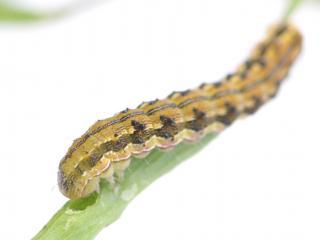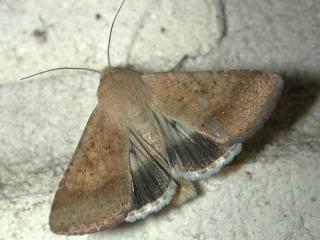Native budworm moth activity. Trapping has finished for the season
Caterpillar activity
- Moora
- Central agricultural region
- Cunderdin
- Brookton
- Cuballing
- Varley
- Cascade
- Scaddan
Technical officer Dave Nicholson (DPIRD) has found three native budworm caterpillars (15-20 mm long) per 10 sweeps in a lupin crop at Moora. The pods are still very green.
An agronomist has continued to find budworm caterpillars chewing into lupin and canola pods in unsprayed crops across the central agricultural region.
A grower near Cunderdin reports finding above threshold numbers of native budworm caterpillars in their canola, lupin and field pea crops.
A grower near Brookton reports finding significant numbers of native budworm caterpillars in canola crops and serradella pasture recently. The farmer commented that the infestations were the worst they had seen for many years and urged farmers to check their serradella pastures for the presence of native budworm caterpillars.
A farmer north of Cuballing has been sweep netting podding canola and lupin crops and has found between 20-30 native budworm caterpillars per 10 sweeps in both crop types.
A farmer near Varley reports finding five budworm caterpillars per 10 sweeps in a podding field pea crop, a control spray of alphacypermethrin has been applied to reduce grub numbers.
Budworm is posing ongoing issues for growers in the Esperance region with very high numbers found in some canola crops near Cascade and a grower at Scaddan has sprayed his podding field pea crop for budworm this week.
Serradella crops that are to be harvested for seed should be regularly checked for native budworm caterpillars. Caterpillars eat increasing quantities of seed and plant material as they grow with the last two growths stages (fifth and sixth instar 20-40mm) responsible for eating over 90% of their total plant consumption. The final two instars can cause considerable seed yield loss in a very short space of time. Along with serradella, lucerne, clover and annual medic seed crops may also be attacked.
Serradellas are reasonably easy to net if they haven’t been grazed hard. If seed production is important then spray control is required where grubs are found (1-2 grubs per 10 sweeps) whilst the plants have green immature pods.
One well-timed spray of registered rates of synthetic pyrethroid chemical to control native budworm should be sufficient in most situations to kill the caterpillars present.
Native budworm moth surveillance
- Usual automated and manual trapping locations
This week’s larger moth flight captures include; Kojonup (250 moths), Pingrup (180), Cuballing north (162) and Maya east (85).
Results of this week's automated and manual trappings are available at the department’s Native budworm moth numbers 2018.
This was the final week of native budworm moth trapping as any future moth flights and egg laying will not be a threat to crops. The efforts of this season’s volunteer native budworm moth trappers, in sending in weekly reports to PestFax and providing advanced warning of the budworm threat, are greatly appreciated.
All late maturing pulse and oilseed crops should be checked for native budworm, especially in areas where moth numbers have been recorded in the past 3-4 weeks.
A mapped view of the native budworm trap captures is available at cesar’s MothTrapVisWA page. Viewers need to select the desired trapping date range.
For more information on native budworm control refer to DPIRD’s 2018 PestFax Issue 22 article Native budworm moth flights are increasing in numbers and distribution and Management and economic thresholds for native budworm page.
Be mindful of withholding periods near harvest
Farmers with native budworm caterpillars in their crops need to be mindful of insecticide withholding periods (WHP) close to harvest and remember that windrowing is classified as harvest.
For more information on insecticides refer to the department’s Winter/Spring Insecticide Spray Chart 2018.
For more native budworm moth information contact Alan Lord, Technical Officer, South Perth on +61 (0)8 9368 3758 or +61 (0)409 689 468.
For more information on native budworm and serradella contact Angelo Loi, Senior Research Officer, South Perth on +61 (0)8 9368 3907 or +61 (0)429 378 279.


